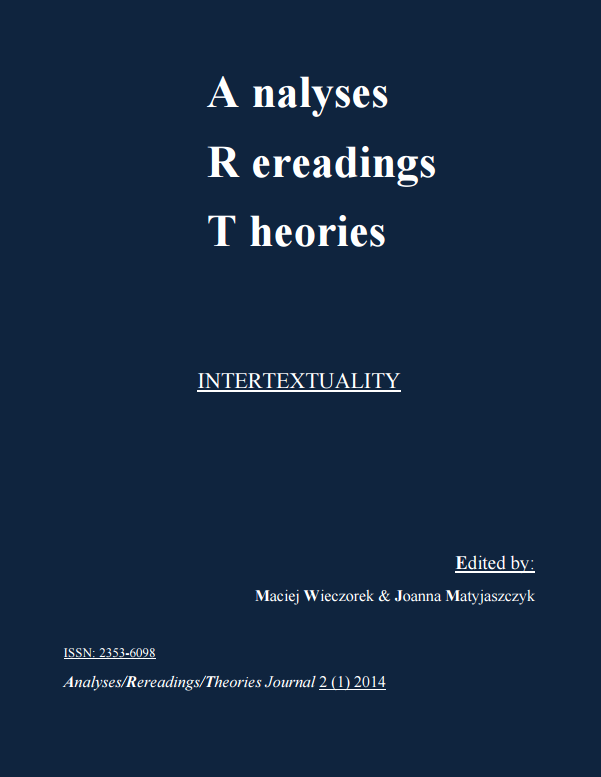Women and Intertextuality: On the Example of Margaret Atwood’s The Penelopiad
DOI:
https://doi.org/10.18778/2353-6098.2.03Keywords:
intertextuality, feminist literary criticism, arachnology, reinterpretation, humourAbstract
The aim of the study is to consider feminist retellings of myths and legends. As an example, Margaret Atwood’s book The Penelopiad is analyzed. The interpretation is situated in a broader context of intertextual practices characteristic of the feminist vision of literature. I present the ideas which Atwood shares with authors engaged in women’s movement. Among these there is Atwood’s understanding of intertextuality (noticeable especially in The Penelopiad). Bibliographical basis of the study comprises books which are fundamental to feminist and gender criticism (e.g. Poetics of Gender, ed. by N. Miller, New York 1986; S. M. Gilbert, S. Gubar The Madwoman in the Attic. The Woman Writer and the Nineteenth- Century Literary Imagination, New Haven and London 1984). What is more, the study refers to the books which allow considering the notion of intertextuality (G. Allen, Intertextuality, London and New York 2010, J. Clayton. E. Rothstein (eds.), Influence and Intertextuality in Literary History, Wisconsin 1991) and connecting the interpretation with the problems crucial to contemporary literary studies (L. Hutcheon L. A Poetics of Postmodernism. History, Theory, Fiction, New York and London 1988, B. Johnson, A World of Difference, Baltimore and London 1989).
References
Abrams, Meyer Howard. A Glossary of Literary Terms. New York: Holt, Reinehart and Winston, 1981. Print.
Google Scholar
Abrams, Meyer Howard. A Glossary of Literary Terms. New York: Holt, Reinehart and Winston, 1981. Print.
Google Scholar
Aristotle. On Poetry and Music. Trans. Samuel H. Butcher. Indianapolis: The Bobbs-Merrill Company, 1985. Print.
Google Scholar
Atwood, Margaret. The Penelopiad. Edinburgh: Canongate Books, 2005. Print.
Google Scholar
Atwood, Margaret. Introduction. The Penelopiad. Edinburgh: Canongate Books, 2005. xiii–xv. Print.
Google Scholar
Bakhtin, Mikhail. “Epic and Novel.” The Dialogic Imagination. Four Essays by M. M. Bakhtin. Ed. Michael Holquist. Trans. Caryl Emerson and Michael Holquist. Austin: U of Texas P, 1981. 3–40. Print.
Google Scholar
Bakhtin, Mikhail. Rabelais and His World. Trans. Hélène Iswolsky Bloomington: Indiana UP, 1984. Print.
Google Scholar
Clayton Jay, and Eric Rothstein. “Figures in the Corpus: Theories of Influence and Intertextuality.” Influence and Intertextuality in Literary History. Wisconsin: U of Wisconsin P, 1991. 3–60. Print.
Google Scholar
Cuddon, John Anthony. The Penguin Dictionary of Literary Terms and Literary Theory. Harmondsworth: Penguin Beds Group, 1992. Print.
Google Scholar
Draine, Betsy. “Chronotope and Intertext: The Case of Jean Rhys’s Quartet.” Influence and Intertextuality in Literary History. Ed. Jay Clayton and Eric Rothstein. Wisconsin: U of Wisconsin P, 1991. 318-25. Print.
Google Scholar
Friedman, Susan Stanford. “Weavings: Intertextuality and the (Re)birth of the Author.” Influence and Intertextuality in Literary History. Ed. Jay Clayton and Eric Rothstein. Wisconsin: U of Wisconsin P, 1991. 148-80. Print.
Google Scholar
Gilbert, Sandra M., and Susan Gubar. The Madwoman in the Attic. The Woman Writer and the Nineteenth-Century Literary Imagination. New Haven: Yale UP, 1984. Print.
Google Scholar
Głowiński, Michał. Intertekstualność, groteska, parabola. Szkice ogólne i interpretacje. Kraków: Universitas, 2000. Print.
Google Scholar
Hutcheon, Linda. A Poetics of Postmodernism. History, Theory, Fiction. New York: Routledge, 1988. Print.
Google Scholar
Johnson, Barbara. A World of Difference. Baltimore: John Hopkins UP, 1989. Print.
Google Scholar
Kraskowska, Ewa. Czytelnik jako kobieta: wokół literatury i teorii. Poznań: Wydawnictwo Naukowe UAM, 2007. Print.
Google Scholar
Kristeva, Julia. “Problemy strukturowania tekstu.” Trans. Wiktoria Krzemień. Pamiętnik Literacki 4 (1972): 233–50. Print.
Google Scholar
Kristeva, Julia. “Revolution in Poetic Language.” Trans. Margaret Waller. Kristeva Reader. Ed. Toril Moi. New York: Columbia UP, 1986. 89–136. Print.
Google Scholar
Kristeva, Julia. “Word, Dialogue and Novel.” Trans. Alice Jardine, Thomas Gora and Léon S. Roudiez. Kristeva Reader. Ed. Toril Moi. New York: Columbia UP, 1986. 34–61. Print.
Google Scholar
Markiewicz, Henryk. Literaturoznawstwo i jego sąsiedztwa. Warszawa: PWN, 1989. Print.
Google Scholar
Miller, Nancy. “Arachnologies.” The Poetics of Gender. New York: Columbia UP: 1986. 270-95. Print.
Google Scholar
Rajan, Tilottama. “Intertextuality and the Subject of Reading/Writing.” Influence and Intertextuality in Literary History. Ed. Jay Clayton and Eric Rothstein. Wisconsin: U of Wisconsin P, 1991. 61-74. Print.
Google Scholar
Rulewicz, Wanda. “Intertextuality, Competence, Reader.” Kwartalnik Neofilologiczny 2 (1987): 229–41. Print.
Google Scholar
Showalter, Elaine. A Literature of Their Own. British Women Novelists from Brontë to Lessing. Princeton: Princeton UP, 1977. Print.
Google Scholar
DOI: https://doi.org/10.1515/9780691221960
Sławiński, Janusz, ed. Słownik terminów literackich. Wrocław: Ossolineum, 2002. Print.
Google Scholar
Steele, Jeffrey. “The Call of Eurydice: Mourning and Intertextuality in Margaret Fuller’s Writing.” Influence and Intertextuality in Literary History. Ed. Jay Clayton and Eric Rothstein. Wisconsin: U of Wisconsin P, 1991. 271-97. Print.
Google Scholar
Downloads
Published
How to Cite
Issue
Section
License

This work is licensed under a Creative Commons Attribution-NonCommercial-NoDerivatives 3.0 Unported License.









